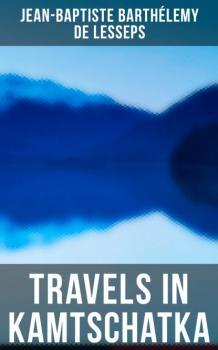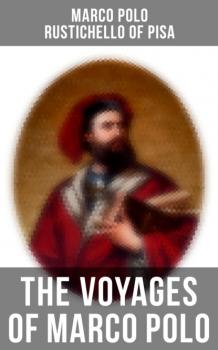Книги о Путешествиях
Различные книги в жанре Книги о ПутешествияхRadel dich satt Hamburg & Umgebung
Schlemmen ohne schlechtes Gewissen? Ja, das geht! Schnappen Sie sich Ihr Rad und folgen Sie Herbert Rönneburg auf seinen 25 entspannten Schlemmertouren in und um Hamburg. Belohnen Sie sich nach einer erlebnisreichen Radtour mit einem Fischbrötchen auf Brücke 10, genießen Sie im Café Engel den Blick auf die Elbe oder speißen Sie in historischem Ambiente im Stoof Mudders Krog. Radfahrn und Schlemmen, noch nie wurde einem Genuß leichter gemacht.
Кофейные Истории
Серия коротких зарисовок о завсегдатаях кафе. Это эмоциональные рассказы о совершенно разных людях, коротающих время в той или иной кофейне. И за каждой историей угадывается своя непростая судьба…
Seeing Europe through the Eyes of the Famous Authors (Vol. 1-8)
A two-fold purpose has been kept in view during the preparation of this book – on the one hand, to refresh the memories and, if possible, to enlarge the knowledge, of readers who have already visited Europe; on the other, to provide something in the nature of a substitute for those who have not yet done so, and to inspire them with new and stronger ambitions to make the trip. Contents: Great Britain and Ireland: London Cathedrals and Abbeys Castles and Stately Homes English Literary Shrines Other English Scenes Scotland Ireland France and the Netherlands: Paris The Environs of Paris Old Provence Cathedrals and Chateaux Various French Scenes Belgium Holland Germany, Austria-Hungary, and Switzerland: The Rhine Valley Nuremberg Other Bavarian Cities Berlin and Elsewhere Vienna Hungary Austria's Adriatic Ports Other Austrian Scenes Alpine Resorts Alpine Mountain Climbing Other Alpine Topics Italy, Sicily, and Greece: Rome Florence Venice Three Famous Cities Naples and Its Environs Other Italian Scenes Sicilian Scenes The Mainland of Greece The Greek Islands
Gardens of the Caribbees (Vol. 1&2)
This work features the sketches written during a cruise to the West Indies and the Spanish Main in the winter and spring of 1901. The author's intention was not to write a West Indian guide-book, but rather to give preference to the human side of the picture through glimpses of the people and their ways of life and thought. With this idea it was thought best to give attention only to such of the ports visited as were full of human interest and typical of the life about the Caribbean Sea. The author believed that it might be of interest to remember as well that at no time since could this voyage have been made under the same conditions: by the publishing of this book in 1903, several ports have become dangerous because of fever and plague; proclamations in French and pronunciamientos in Spanish have adorned West Indian street corners; Haiti has reverted to its almost chronic state of riot and revolution; the Dominican republic has again chosen a President whose nomination came from a conquering army; Venezuela has been full of alarms and intrigues; while already the Germans were beginning to show their hand in the Caribbean; Martinique and St. Vincent have been desolated by volcanoes then thought to be practically extinct; and of delicious St. Pierre there remained but a sadly memory. Contents: The Voyage Port-au-Prince, Haiti Santo Domingo San Juan, Puerto Rico Charlotte Amalie, St. Thomas Martinique Martinique, «Le Pays des Revenants» Island of Trinidad, Port of Spain Island of Trinidad, «Iere» Island of Trinidad, La Brea The Spanish Main In Venezuela, Caracas In Venezuela, Caracas to Puerto Cabello Curaçao, City of Willemstad The Southern Cross Kingston, Jamaica "Cuando Salide La Habana" A Memory of Martinique
An Expedition to Mount St. Elias, Alaska (Illustrated Edition)
An Expedition to Mount St. Elias, Alaska is a historical account of the 1889 expedition to Alaska written by American geologist Israel Russell. He represented the United States Geological Survey in an expedition sent to establish a portion of Alaska's eastern boundary. During the next two years, he explored, under the joint auspices of the USGS and the National Geographic Society, the slopes of Mount Saint Elias and the Yakutat Bay area and took notes which, with some additions from his fellow explorers, later became very detailed account of the Expedition.
Travels in Kamtschatka
Jean-Baptiste Barthélemy de Lesseps
This book features a travel account of the scientific expedition led by the French Naval officer and explorer Jean-François de Galaup, count of La Pérouse, written from the perspective of a diplomat who had joined the expedition as an interpreter. The expedition's aims were to complete the Pacific discoveries of James Cook, whom La Pérouse greatly admired, correct and complete maps of the area, establish trade contacts, open new maritime routes and enrich French science and scientific collections. The journey started in August 1785 and took the ships south across the Atlantic Ocean, around Cape Horn to the Pacific, stopping at Easter Island, Hawaii, modern-day Alaska, Macao, Manila, the Sea of Japan, the Sea of Okhotsk and then to the port of Saints Peter and Saint Paul, now Petropavlovsk-Kamchatsky on the eastern side of the Kamchatka Peninsula. Here they rested from their trip, and enjoyed the hospitality of the Russians and Kamchatkans. In letters received from Paris, La Pérouse was ordered to investigate the settlement the British were establishing in New South Wales, Australia. De Lesseps then used a carriage to travel through Krasnoyarsk, Achinsk, Tomsk, Tobolsk, Tyumen, Yekaterinburg, and Kungur in the Ural Mountains to Kazan, where he was injured in an accident. To avoid being caught for another winter, he pressed on to Nizhniy Novgorod, then (Veliky) Novgorod, reaching Saint Petersburg, his intended destination in September 1788, more than a year after he started. Given the subsequent loss of both ships, by leaving at Petropavlovsk, de Lesseps became one of three members of the original cast to survive the La Pérouse expedition.
The Voyages of Marco Polo
The Voyages of Marco Polo is a 13th-century travelogue written down by Rustichello da Pisa from stories told by Italian explorer Marco Polo, describing Polo's travels through Asia between 1271 and 1295, and his experiences at the court of Kublai Khan. The Travels is divided into four books. Book One describes the lands of the Middle East and Central Asia that Marco encountered on his way to China. Book Two describes China and the court of Kublai Khan. Book Three describes some of the coastal regions of the East: Japan, India, Sri Lanka, South-East Asia, and the east coast of Africa. Book Four describes some of the then-recent wars among the Mongols and some of the regions of the far north, like Russia. Polo's writings included descriptions of cannibals and spice-growers.
Chinas neuer Imperialismus
Im Gegensatz zur Auffassung mancher europäischer Linker kann Anton Stengl, der selbst viereinhalb Jahre in China arbeitete, keinerlei sozialistische Ausrichtung in der aktuellen Politik Chinas erkennen. Das Reich der Mitte ist seiner Analyse nach in wirtschaftlicher Hinsicht zur Fortsetzung des Kapitalismus und der Verteidigung seines Warencharakters angetreten und agiert geopolitisch als aufstrebende Hegemonialmacht. Im gigantischen Projekt der «Neuen Seidenstraße» («One Belt, One Road») ortet der Autor den Dreh- und Angelpunkt des neuen chinesischen Imperialismus. Seiner Ansicht nach ist dieses Vorhaben einer klassischen kapitalistischen Überproduktionskrise geschuldet. Vehemente staatliche Eingriffe in die Ökonomie dienten auch historisch oft zur Überwindung einer Verwertungskrise. Der große Vorteil für chinesisches Kapital in den ersten Jahrzehnten des 21. Jahrhunderts besteht gerade in dieser kontinuierlichen staatlichen Absicherung seiner Verwertungsmöglichkeiten, der staatlichen Finanzierung und dem Ausbau staatlicher Infrastruktur. In einem eigenen Kapitel wird der Frage nachgegangen, welches Wirtschaftssystem in China vorherrscht: ein noch unterentwickelter Sozialismus (der den Umweg über den Kapitalismus nehmen muss, um voranzukommen)? Oder ein Staatskapitalismus der besonderen Art? Zwei Kriterien sind für die Beantwortung der Frage entscheidend: die Eigentumsfrage und – damit verbunden – die Frage nach den wirtschaftlichen Prinzipien. Beide beantwortet der Autor eindeutig: In China regieren Markt und Privateigentum und die Wirtschaft funktioniert nach den Regeln von Profit und Konkurrenz. In geopolitischer Hinsicht ist Vietnam ein gutes Beispiel dafür, welche konkreten Auswirkungen der chinesische Imperialismus auf die Länder in Asien hat. Es geht um die Ausbeutung von Rohstoffen und Arbeitskräften an verlängerten Werkbänken in Sonderwirtschaftszonen bis hin zum territorialen Anspruch auf Inseln im Südchinesischen Meer, wenn dort Erdölfunde vermutet werden. Das Buch endet mit einer Analyse der Vorgänge in Hongkong und in Xinjiang.
Radtouren am Wasser Mecklenburgische Seenplatte
Sie wollen den anstrengenden Alltag hinter sich lassen? Sich an der frischen Luft bewegen? Den Geräuschen des Wassers lauschen? Dann ist dieser Radführer genau das Richtige für Sie! Schwingen Sie sich auf ihr Rad und genießen Sie die traumhafte Mecklenburgische Seenplatte. 30 entspannte Fahrradtouren am Wasser fernab vom Motorverkehr werden Ihnen zeigen, wie schön und erfrischend Radfahren sein kann.
Medio Oriente, lugar común
Ezequiel Kopel conoce como pocos la región más caliente del mundo. Y, lo más importante, se esfuerza por explicarla. En este libro tan profundo como claro, recurre a la historia, el análisis político y su experiencia personal sobre el terreno para desmontar uno a uno los mitos más importantes, discutir verdades que se dan por incontrastables y revelar la endeblez de ciertas interpretaciones. Solo así será posible acceder a una comprensión cabal de la compleja problemática de una región que todos los días desafía nuestros prejuicios.









